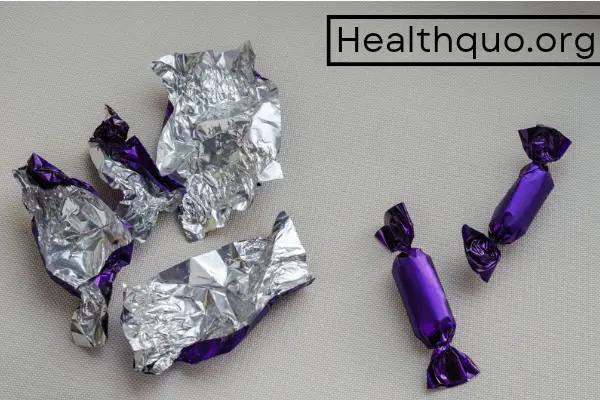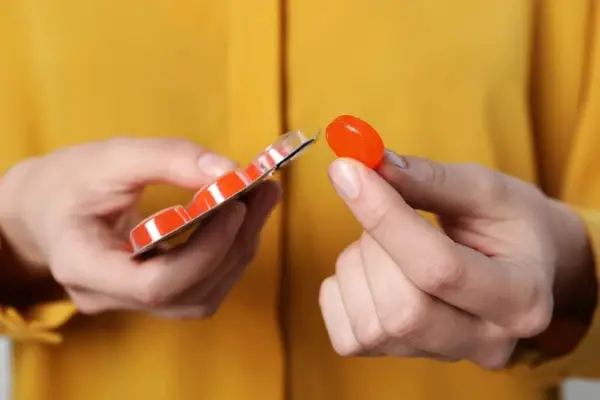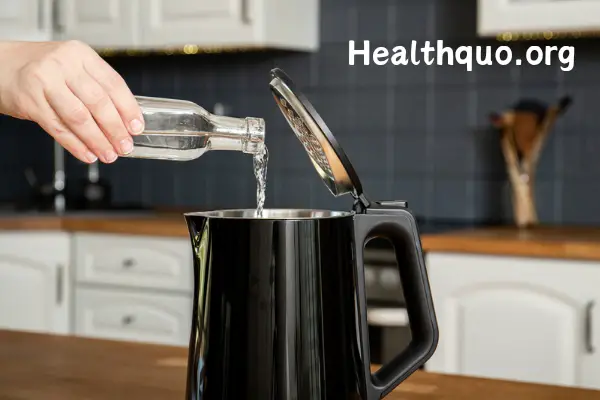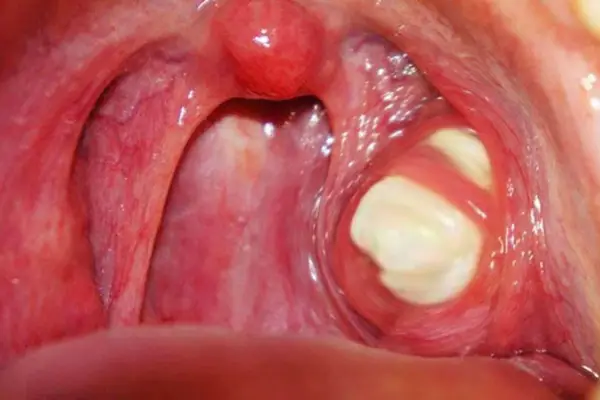The accidental ingestion of a candy wrapper can be a concerning experience, whether it occurs out of curiosity, distraction, or the enjoyment of a sweet treat. These thin sheets designed to keep candies fresh and clean are not intended for consumption, and their accidental ingestion raises questions about potential health implications.
While the human body is remarkably adept at dealing with non-food items that find their way into the digestive system, the experience can vary depending on the size and material of the wrapper, as well as the individual’s overall health.
An insight into what happens when a candy wrapper is swallowed, the potential risks involved, and when to seek medical attention can help mitigate anxiety and ensure appropriate actions are taken.
What Are Candy Wrappers Made Of?
Candy wrappers are made from a variety of materials, each chosen for its specific properties like durability, flexibility, and the ability to preserve the freshness of the candy inside. Here are the primary materials used in candy wrappers:
1. Plastic
Plastics are widely used for candy wrapping due to their versatility and protective qualities. They can be transparent or colored and are excellent at keeping moisture out and flavors in. Common types of plastics used include polyethylene, polypropylene, and cellophane (which, while originally derived from cellulose, is often considered in the plastic category due to its similar use and properties).
2. Aluminum Foil
Foil wrappers are commonly used for chocolates and gum. Aluminum foil is favored for its ability to completely block light, oxygen, moisture, and bacteria, making it an excellent choice for products that are sensitive to these elements. It’s also easily moldable, allowing for tight wrapping that conforms to the shape of the candy.
3. Paper
Paper is another material frequently used for candy wrappers, especially for products that are less sensitive to moisture and air exposure. Paper wrappers can be plain, wax-coated, or laminated with a thin layer of plastic or aluminum to improve their protective qualities. They’re often used for candies that are meant to be consumed quickly after purchase, such as candy bars or individual pieces in larger bags.
4. Wax Paper
Wax paper is paper that has been coated on both sides with food-grade wax, providing a non-stick surface and some moisture resistance. It’s commonly used for wrapping candies that might stick to regular paper, such as taffies or caramels.
5. Laminates
Many candy wrappers are made from laminates, which are composite materials created by bonding two or more types of material together. For example, a wrapper might have a layer of aluminum foil for its barrier properties and a layer of paper or plastic for strength and printability. This combination allows manufacturers to take advantage of the best properties of each material.
6. Biodegradable and Edible Materials
There’s growing interest in sustainable packaging solutions, leading to the development of biodegradable and even edible wrappers for candies. These can be made from various organic materials, including plant-based plastics (polylactic acid, or PLA), seaweed, rice paper, and other natural substances designed to break down more quickly than traditional materials or be consumed along with candy.
Is Candy Wrapper Harmful If Swallowed? Health Implications
Plastic wrappers are made from various synthetic materials, which are not designed for digestion. If swallowed inadvertently, a small piece of plastic wrapper will readily pass through the gastrointestinal tract and be expelled, but a larger piece might be more concerning.
Sometimes, a piece of plastic wrapper can get stuck in the esophagus causing a feeling of obstruction. Choking hazards are a primary concern, particularly for children.
In some cases, gastrointestinal upset can occur and the individual may present with symptoms like abdominal pain, nausea, or fever. Additionally, certain plastics may contain potentially harmful chemicals but the amount of plastic leached into the body from a single small piece is often low.
A small piece of aluminum foil, when accidentally ingested, is usually harmless to most individuals, as it tends to pass through the digestive system without being absorbed. As with other foreign objects, there’s a risk of choking and gastrointestinal discomfort, particularly in children.
Long-term accumulation of aluminum in the body has been studied for possible links to neurological conditions. However, the risk of acute toxicity is negligible with such small amounts of aluminum in a candy wrapper. Also, the short transit time in the stomach prevents a significant chemical reaction.
Paper wrappers are perceived as less risky compared to plastic and foil wrappers due to their organic nature. They are more likely to break down within the digestive system. However, they still pose a choking hazard, especially for young children. Additionally, the inks and dyes used on some paper wrappers could potentially contain toxic substances, though the quantity ingested from wrapper paper is likely to be too small to cause harm.
Wax paper is coated with a thin layer of wax to make it moisture-resistant. This type of wrapper poses similar risks to plain paper wrappers, including the potential for choking. The wax coating, while generally food-safe, could cause mild gastrointestinal upset if consumed in significant amounts, though this is unlikely with the small amounts found on candy wrappers.
Candy wrappers made from biodegradable materials are designed to be environmentally friendly, often made from plant-based substances. These wrappers are generally safer to ingest than their plastic or foil counterparts due to their natural composition.
However, they can still present a choking hazard or cause gastrointestinal discomfort if swallowed, especially in larger pieces. The specific risks would depend on the materials used (e.g., cornstarch, potato starch), but overall, they’re less likely to cause harm compared to synthetic materials.
First Aid For Adults and Children Choking On Candy Wrappers
If a candy wrapper gets stuck in the windpipe (trachea), it can obstruct the flow of air to the lungs, leading to choking. This scenario is acute and requires immediate attention.
The individual may exhibit signs of distress such as inability to speak, cough, or breathe, coupled with panic, face turning blue, or loss of consciousness if the blockage is not quickly resolved. Choking on an object like a candy wrapper is a life-threatening emergency because it cuts off the oxygen supply to the brain.
1. Encourage Coughing
If the person can cough forcefully, encourage them to continue coughing. Forceful coughing is one of the most effective ways to dislodge an object from the windpipe.
2. Perform Abdominal Thrusts (Heimlich Maneuver) or Back Blows
For adults and children over 1 year, stand behind the person, wrap your arms around their waist, and place a fist just above their navel. Grab your fist with your other hand and perform a quick, upward thrust. Repeat up to five times if necessary.
For pregnant women or obese individuals, perform chest thrusts instead. Place your hands at the base of the breastbone, just above the joining of the lowest ribs, and press hard into the chest with a quick thrust.
For infants, after delivering back blows, turn the infant face up, keeping their head lower than their chest. Place two fingers in the center of their chest just below the nipple line and give five quick chest thrusts.
3. Call for Help
Immediately call emergency services or instruct someone else to do so. Time is critical in a choking emergency.
4. Repeat Until the Object is Dislodged
Continue alternating five back blows and five abdominal or chest thrusts until the blockage is cleared or emergency services arrive. If the person becomes unconscious, begin CPR if you’re trained to do so, and continue until help arrives.
Facilitating the Passage of an Ingested Candy Wrapper
If a candy wrapper is accidentally swallowed without causing choking or discomfort, you can take cautious steps to aid its passage through the digestive system:
Stay Hydrated: Drinking water or other clear fluids can help keep the digestive system flowing and might aid in moving the wrapper through more easily. However, ensure the person is not having difficulty swallowing before offering liquids.
Eat Fiber-Rich Foods: If the person feels no discomfort and can swallow easily, eating a meal rich in fiber could help move the swallowed object through the digestive tract. Foods like whole grains, fruits, and vegetables can help form bulkier stools, which might encase the wrapper and assist in its passage.
Avoid Inducing Vomiting: This could cause more harm or complications.
Monitor for Symptoms: Watch for any signs of discomfort, abdominal pain, or difficulty in bowel movements.
Seek Medical Advice: If you’re concerned or if symptoms develop, consult a healthcare professional for guidance.
Signs and Symptoms That Warrant Medical Attention
- Difficulty breathing
- Choking Or coughing
- Persistent abdominal or chest pain or discomfort
- Nausea Or vomiting
- Wheezing
- Drooling
- Fever
What to Expect During a Medical Evaluation
During a medical evaluation for ingesting a candy wrapper, you can expect the following steps:
- Medical History and Physical Examination: The doctor will ask about the incident, the type and size of the wrapper ingested, and any symptoms experienced. A physical exam will be conducted to check for signs of distress or obstruction.
- Diagnostic Tests: Depending on the symptoms and the initial assessment, diagnostic tests such as X-rays or ultrasounds may be performed to locate the wrapper and assess if there’s an obstruction.
- Treatment Plan: If the wrapper is not causing an obstruction or immediate harm, the doctor may recommend monitoring the situation and waiting for it to pass naturally. In cases of obstruction or severe symptoms, more direct intervention, such as endoscopy or, in rare cases, surgery, may be necessary to remove the wrapper.
- Follow-up: The doctor might suggest a follow-up visit or phone call to ensure that the wrapper has passed and that no further complications have arisen.
Tips for Preventing Accidental Ingestion
Accidental ingestion of candy wrappers can be avoided through proactive measures and heightened awareness, especially in households with children. Here are some practical prevention tips:
Educate About Risks: Teach both adults and children about the dangers of swallowing non-food items, including candy wrappers. Emphasize the importance of unwrapping candies before consumption.
Supervise Children: Always supervise young children while they are eating candies or other wrapped foods. Children are more likely to swallow items accidentally due to curiosity or inattention.
Safe Storage: Keep candies and other small, wrapped items out of reach of children. Store them in high cabinets or lockable drawers to prevent unsupervised access.
Practice Mindful Eating: Encourage taking time to eat, which includes unwrapping candies slowly and carefully, to reduce the risk of accidentally swallowing wrappers.
Regular Cleanups: Maintain a clean eating and playing environment for children to minimize the risk of them picking up and ingesting random objects, including candy wrappers.





